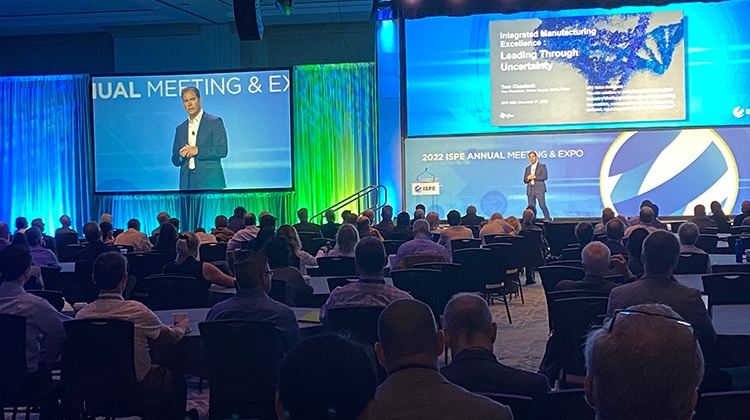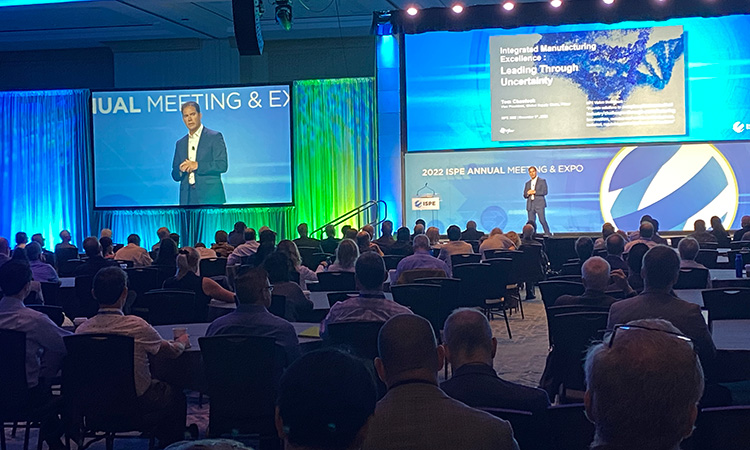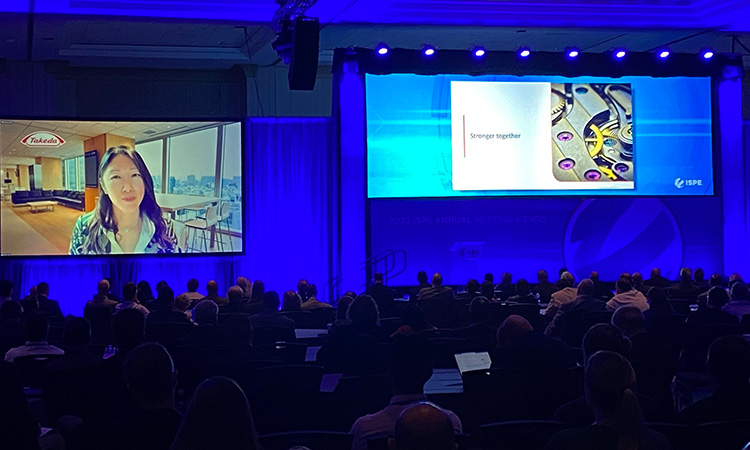2022 ISPE Annual Meeting: Transform, Collaborate, & Innovate for the Path Forward

The industry is in the process of a transformation that was sped up by the pandemic, which enhanced innovation and collaboration. Applying what has been learned over the last three years to update pharmaceutical companies’ approaches to development and implementation is key as the industry crafts its strategies in an increasingly digital and global environment. The keynote presentations on 1 November at the 2022 ISPE Annual Meeting & Expo in Orlando provided three illustrations of approach. The goal, as always, is to help patients.
Leading through Uncertainty

Tom Cheslock, Vice President, Hospital Business Unit Global Supply Chain at Pfizer presented on “Integrated Manufacturing Excellence–Leading thru Uncertainty.” He shared Pfizer’s approach to reinventing to be able to develop medicines and vaccines faster, an approach that is helping pave the way to future development.
Cheslock noted the many initiatives that pharmaceutical companies including Pfizer have—top down and bottom up site initiatives—and noted the challenge is to integrate all of these efforts to deliver full impact. Pfizer’s approach is its integrated manufacturing excellence (IMEx) production system, which was in place prior to the pandemic and helped the company to move quickly in vaccine and treatment development. The system installs a standardized “one best way” of organizing work at each site. Processes are integrated to drive higher performance and the integrated system delivers continuous improvement, he said.
The system starts at the shop floor, and follows all the way through each level of production in process-centric teams. This approach allowed Pfizer to keep producing and operating through pandemic, and lessons were learned along the way on how to pivot to include new areas. The first innovation was to secure the supply of critical medicines for COVID-19 patients, followed by reinventing the manufacturing process to ramp up vaccine production in record time, and then optimizing deep frozen distribution on a global scale.
Pfizer “cleared runway to allow for large-scale vaccine manufacturing before we had a product!” while clinical trials were still underway, he said. Pfizer was able to build close to two years of supply of products for the vaccine; it had to quickly scale up for producing billions of doses in a very short period of time, so Pfizer looked to ramp up drug substance, drug product, and packaging in many sites around the world in record time. Pfizer initially did not know temperature profile of the final vaccine product but needed a shipment means for a range of temperatures; it came up with deep frozen distribution on a global scale. These innovations were done in parallel, he noted.
Lightspeed culture to sustain the gains made during this period began: How to make decisions make faster and how to break through bureaucracy faster. The goal, Cheslock said, is to get manufacturing to keep up with the ever faster speed of digital tools and the speed of science.
He noted the contribution of partners and other vaccine manufactures who worked on the process of distribution through this time. “You should all be really proud of the work you do and how it impacts patients,” he said.
The pandemic work and the use of the production management system has helped to ground Pfizer in managing through ongoing uncertainties that include:
- Equity: how to create global access to medicines
- Geopolitical: what’s happening around the world
- Free trade/economic policies: how to manage through a recession
- Sustainability
“Around all this, we want to be innovative and reliable,” Cheslock said. What pharmaceutical manufacturers do “must be repeatable and reliable amidst all these uncertainties when making a vaccine.”
The industry needs innovative solutions and partnerships to keep going with what was learned during the pandemic. Maintaining a patient-centric focus, while being able to move quickly to make decisions, move ahead without delays from bureaucracy, how to quickly ramp up and deescalate, while mitigating risk and making the right mix of products at the right time in the most risk-averse way—these are the lessons that are being taken into the future.
-

Tom Cheslock
-

Julie Kim
-

Andres Angelani
Science and Art of Collaboration
Collaboration came to the forefront during the pandemic, but it is not a new concept to the pharmaceutical industry. It is one that should continue to be a focus, and Julie Kim, President, US Business Unit and US Country Head, Takeda, shared thoughts on the way collaboration can continue to help pharmaceutical companies to serve patients.

In her presentation, “The Science (and Art) of Collaboration to Keep the Patient First,” Kim used Swiss watch production, a superior level of quality, as an analogy for how successful partnerships among pharmaceutical companies can work with collaboration and connection. Just as the scientific (engineering and mechanical) components each must be high quality in a watch, so must they be in pharmaceutical manufacturing. “When the components work together flawlessly as one unit, that’s the science. Then, the art: the materials for each part, selected carefully to work well and also to be beautiful,” Kim said. “When we extend the analogy to pharma industry, we too are at intersection of science and art. We bring incredible innovations to patients at all stages of their journeys.”
While partnering used to be more in research and development, Kim said that now partnerships are going beyond R&D to encompass scaling production and distribution in biologics and vaccines, and also intra-industry collaborations.
Good collaborations need a common objective, to leverage the strengths of each partner, and mutual definitions of success. Patients are the common objective of each organization in the health care industry including the pharmaceutical industry. Each partner has its own strengths and may have different ways of making their contribution to the end result—producing a new drug or therapy. Working together with these different approaches is often not done well or done across the whole partnership, Kim said. Losing sight of a long-term, difficult objective could take the work off course and the objective may be missed, so early and quick course correction is key. Change is a constant, but collaborators “always need to be able to see the destination and recalibrate.” Working with partners also allows co-creation to fuel innovation, she said.
The strongest partnerships are clear and intentional about how success is measured, she said. Each partner holding themselves and other partners responsible for quality protects the collective value of the pharmaceutical, just as the Swiss watchmakers do with the production of the various components needed to make the watch. Figure out what success looks like for the whole collaboration, and more importantly, for patients, she said.
She acknowledged that this can be complex with more stakeholders and integrating data into all processes, so it is even more critical to agree early on roles and responsibilities and reinforce them often.
Creating partnerships can be easy, but figuring out how to work together, the strengths of each partner, and defining parameters and metrics, takes work to establish a foundation to work toward success, Kim said. Strong and transparent communications and trust are tied to this. Celebrate success and milestones.
Digital Transformation
Andres Angelani, Senior Vice President and Global Head of Digital Engineering at Cognizant Technology Solutions, presented on “Digital Transformation From Vision to Reality.” He spoke about how to meet goals in the quick moving digital environment and in the wake of the boundaries that were pushed during the pandemic.
Digital innovation is now core to the pharmaceutical industry, he said. It needs to be part of everything; “sectorizing” it will slow you down, Angelani said. Changes to the operating model need to include what he called a “talent ecosystem” so that the organization can incorporate digital innovation. This draws on multiple functions and talents to contribute to the whole.
Figuring out what talent ecosystem is needed to achieve your organization’s goals includes asking questions. Is there a pattern, a way to figure out what you are working on? Is there capacity you need to develop? Are you missing capabilities? Are outside consultants needed? Do you need vendors to help scale up, build, or design? Where to do it—in house, on site, here or off shore? All these questions come up when introducing digital, Angelani explained.
He encouraged attendees to consider the connection of all of these, and to embrace velocity: empower teams to adopt innovation in how they approach a product and how they partner. Going outside of the company for partnerships can help to incorporate digital instead of endlessly reorganizing internally, he said. When the company is open to doing this, you can see what redundancies you may have, how to rearrange, and what partnering is needed to achieve your goals.
He encouraged thinking about a network of what he termed “specialized studios” to fulfill the needs, and studios have a value proposition, learn from experience, and adapt how they do things so they can deliver on outcomes.
Angelani illustrated with an example of his company’s partnering with a pharmaceutical company to build an app for patients with Crohn’s disease and ulcerative colitis. The goal was to help these patients, and the medication was just part of the concept that was suggested: an app overlaid with augmented reality that helped show patients where to inject the medication and to do it safely, log foods and track triggers, help identify where to go in case of an emergency. The result: an improved patient experience that provides patient feedback, access to data, and extends pharma’s role beyond the “traditional” one of providing just drugs.
He suggested focusing on value rather than cost issues when considering partnering. Other suggestions: embrace innovation with velocity and purpose; secure the best software talent; select passionate, relentless partners; empower everyone to work together; build new tools and launch new products; and think big.




